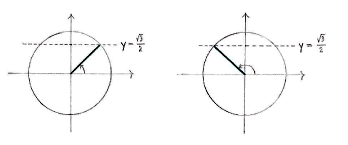Lösung 4.4:2a
Aus Online Mathematik Brückenkurs 1
K (hat „Solution 4.4:2a“ nach „Lösung 4.4:2a“ verschoben: Robot: moved page) |
|||
| Zeile 1: | Zeile 1: | ||
| - | + | Wir zeichnen den Einheitskreis, und markieren alle Winkeln die die 'y''-Koordinate <math>\sqrt{3}/2</math> haben. So erhalten wir alle Lösungen der Gleichung zwischen <math>0</math> und <math>2\pi</math>. | |
| - | <math>0</math> | + | |
[[Image:4_4_2_a.gif|center]] | [[Image:4_4_2_a.gif|center]] | ||
| - | + | Im ersten Quadrant wissen wir dass <math>x = \pi/3</math> den Sinus <math>\sqrt{3}/2</math> hat. Noch dazu hat die Spiegelung in der ''y''-Achse denselben Sinus, und also ist <math>x = \pi - \pi/3 = 2\pi/3</math> auch eine Lösung. | |
| - | + | Addieren wir einen Multipel von <math>2\pi</math> zu irgendeiner dieser Winkeln, ändert sich nicht deren Sinus. | |
| - | {{Abgesetzte Formel||<math>x = \frac{\pi}{3}+2n\pi\qquad\text{ | + | {{Abgesetzte Formel||<math>x = \frac{\pi}{3}+2n\pi\qquad\text{und}\qquad x = \frac{2\pi}{3}+2n\pi\,,</math>}} |
| - | + | wo ''n'' eine beliebige ganze Zahl ist. | |
| + | Hinweis: Schreiben wir | ||
| - | + | {{Abgesetzte Formel||<math>x = \frac{\pi}{3}+2n\pi\qquad\text{und}\qquad x = \frac{2\pi}{3}+2n\pi\,\textrm{,}</math>}} | |
| - | + | heißt dies dass die Gleichung für jedes ''n'' erfüllt ist, und also für die Winkeln: | |
| - | + | ||
| - | + | ||
{{Abgesetzte Formel||<math>\begin{array}{llll} | {{Abgesetzte Formel||<math>\begin{array}{llll} | ||
Version vom 21:03, 5. Apr. 2009
Wir zeichnen den Einheitskreis, und markieren alle Winkeln die die 'y-Koordinate \displaystyle \sqrt{3}/2 haben. So erhalten wir alle Lösungen der Gleichung zwischen \displaystyle 0 und \displaystyle 2\pi.
Im ersten Quadrant wissen wir dass \displaystyle x = \pi/3 den Sinus \displaystyle \sqrt{3}/2 hat. Noch dazu hat die Spiegelung in der y-Achse denselben Sinus, und also ist \displaystyle x = \pi - \pi/3 = 2\pi/3 auch eine Lösung.
Addieren wir einen Multipel von \displaystyle 2\pi zu irgendeiner dieser Winkeln, ändert sich nicht deren Sinus.
| \displaystyle x = \frac{\pi}{3}+2n\pi\qquad\text{und}\qquad x = \frac{2\pi}{3}+2n\pi\,, |
wo n eine beliebige ganze Zahl ist.
Hinweis: Schreiben wir
| \displaystyle x = \frac{\pi}{3}+2n\pi\qquad\text{und}\qquad x = \frac{2\pi}{3}+2n\pi\,\textrm{,} |
heißt dies dass die Gleichung für jedes n erfüllt ist, und also für die Winkeln:
| \displaystyle \begin{array}{llll}
&n=0:\quad &x=\frac{\pi}{3}\quad &x=\frac{2\pi }{3}\\[5pt] &n=-1:\quad &x=\frac{\pi}{3}+(-1)\cdot 2\pi\quad &x=\frac{2\pi}{3}+(-1)\cdot 2\pi\\[5pt] &n=1:\quad &x=\frac{\pi}{3}+1\cdot 2\pi\quad &x=\frac{2\pi}{3}+1\cdot 2\pi\\[5pt] &n=-2:\quad &x=\frac{\pi}{3}+(-2)\cdot 2\pi\quad &x=\frac{2\pi}{3}+(-2)\cdot 2\pi\\[5pt] &n=2:\quad &x=\frac{\pi}{3}+2\cdot 2\pi\quad &x=\frac{2\pi}{3}+2\cdot 2\pi\\[5pt] &\phantom{n}\vdots &\phantom{x}\vdots &\phantom{x}\vdots \end{array} |

